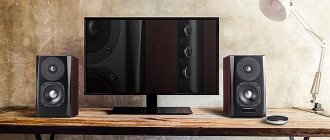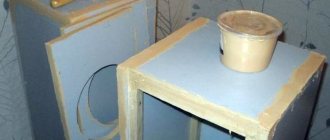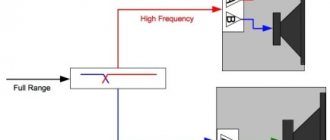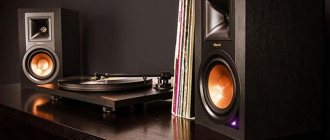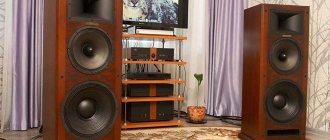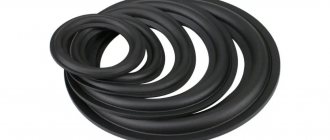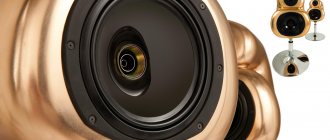If you are wondering what speakers to buy for your PC, read this article - you will probably find something useful for yourself. We will not talk about the frequency response and nonlinear distortion coefficient (those who understand such characteristics do not need “advice from the Internet”). This material is more likely for those who choose their first speaker system. Well, or I chose the first one based on its appearance, but decided to take the purchase of the next one more seriously.
How to choose speakers according to your interests and hobbies? What characteristics should I pay special attention to? How to decipher the numerical designations in the product card? That's what we'll talk about.
Configuration
We can say that the configuration is the number of columns. Designated as follows: 2.0, 2.1, 3.1, 5.1. The first digit indicates the quantity. The number after the dot (can only be 1 or 0) indicates the presence or absence of a subwoofer.
Stereo speakers 2.0
Stereo speakers are the most common type of computer acoustics. They are designed simply: there is no subwoofer, the amplifier is built into one of the speakers. But stereo sound can be of completely different quality and strength.
In configuration 2.0, office tweeters with a total power of 5 W are used, like SVEN 140, which are capable of maximizing the work processes on the computer.
But powerful stereo systems of 200 W or more, which in terms of sound quality even meet the requirements of professionals, can also be 2.0. Edifier R2800 computer speakers are very popular in our store.
2.1
Configuration 2.1. assumes the presence of two speakers and a subwoofer. Like, for example, the SVEN SPS-820 acoustics. This model from 2004 remains in the best ratings in 2019.
Subwoofer is a separate acoustic system for reproducing the lowest sounds (bass) with a frequency of up to 100 Hz. For listening to music, a pronounced, isolated bass sound is not always useful. But low tones perfectly support special effects in movies and computer games. The subwoofer transmits those sounds that we almost cannot hear with the ear, but feel with the chest (like air vibrations) or as “goosebumps”. Therefore, if you want to choose a speaker system for gaming or watching movies, you should choose a configuration with a unit after the dot.
3.1
Another option for such a system is three speakers plus a subwoofer. To the two devices that are installed on both sides of the computer, another one is added here, central. It is better to place it somewhere at the top, above the monitor. By the way, experts recommend placing the subwoofer on the floor. This creates a surround sound effect.
But not all systems of this configuration are connected via a 3.5 linear connector. Therefore, before purchasing, you need to make sure that the sound card of your PC has a connector into which you can connect acoustics. And in general, it’s right to choose speakers for your computer and any peripheral devices with a “cheat sheet” that shows all the connectors and interfaces that your computer supports.
A good example of acoustics with a 3.1 configuration is the CrownMicro CMBS-700.
Dolby Digital 5.1
All movie fans dream of a 5.1 speaker system. Compared to the previous one, it has 2 more columns. “Boxes” are placed around the perimeter of the room. As a result, you can get the effect of being surrounded by sound not only while sitting right in front of the computer, but anywhere in the room. You can display the image from the display on the TV screen (if your monitor is not large enough), sit on the sofa and enjoy an action, thriller or horror film (they are especially rich in sound effects). The disadvantage of a 5.1 configuration is the same as that of 3.1 speakers: the standard sound card of an old computer may not have the required output. Excellent acoustics of this format Microlab FC730 in our catalog are quite inexpensive.
Format 1.0: single column
Columns of type 1.0 with a computer are, as a rule, not used. The sound in such a speaker passes through a channel to a small speaker, like in laptops. But, unlike them, it is not intended for transportation.
Portable speakers connect to a smartphone, laptop or player via Bluetooth, and a 1.0 computer speaker connects via a 3.5 line output. And it is powered from the mains, and not from a battery, so there is no point in taking it anywhere.
But 1.0 speakers can reproduce sound up to 10 W, much louder than laptops, and cost about the same.
Active and passive speakers
An amplifier is needed to convert the electrical signal into sound. Speakers can be active (with a built-in amplifier) or passive (without it). Completely passive speaker systems require an additional “amplifier” to be purchased. Therefore, they are more often chosen by professionals who prefer to assemble acoustics “piece by piece” that would suit them in all respects.
In active speaker systems, as a rule, one speaker is active (it is connected to the computer), and the rest - passive, so-called satellites - are connected to the active speaker. The amplifier needs power. Therefore, the active speaker, in addition to the sound card, is connected to the mains. Low-power models, like the SVEN 140, which we have already discussed, can be connected to a computer via USB. And power from USB is quite enough for them.
In 3.1, 5.1 systems, the amplifier is usually built into the subwoofer.
A compromise solution between active and passive speaker systems can be called models in which the amplifier is placed in a separate housing. As, for example, in the mentioned Microlab FC730. This type of music system for a computer is very convenient to use, since all the controls are located on the amplifier body. When it is built into a subwoofer, all the buttons and knobs are also located on the subwoofer. And if you install the sub on the floor, you will have to bend over each time to adjust the sound, and even get a “low-frequency sonic boom.”
Format 5.1: Dolby Digital
This type of speaker is completely designed for gamers with cool soundtracks and sound effects. The audio system includes two front and two center speakers, as well as a subwoofer. Thus, it provides five-channel surround sound playback in Dolby Digital and DTS formats. These speakers often come with a physical Dolby Digital or DTS-II decoder.
There are budget options in the 5.1 world, but they can't compete with true home theater systems. This will be enough for games.
5.1 speakers allow you to turn your computer into a good home theater; just to do this, of course, you need to connect them. It is extremely rare to find a 3.5mm output here, much more often - an analog RCA output, an optical or coaxial digital output.
Outputs vary depending on cable type and connector shape. The advantages of one type or another are practically invisible to a non-specialist, so there is no point in dwelling on them. You just need to purchase the appropriate adapter for your sound card.
There are cooler layout options: 6:1 and 7:1. But it won't be easy to feel the difference from 5.1.
Characteristics of computer speakers
You won’t be able to decide which speakers are best to buy for your computer if you don’t take into account such parameters as:
- frequency range,
- sensitivity,
- power.
Frequency ranges
Good computer speakers have a wide range of frequencies (from several tens to 20,000 Hz), which can be reproduced by one common speaker (so-called single-way systems). There are two-way models, with two speakers (small for reproducing high frequencies, large for mids and lows). In three-way speaker systems, respectively, there are three per column - each range has its own speaker. This division into “strips” is good when it is implemented well by the manufacturer. Music lovers often note “dips” in sound at the junctions of frequency ranges. A good single-way speaker sounds better than a low-quality three-way speaker.
Sensitivity
The sensitivity of a speaker system is its sound pressure one meter from the speaker at a power of 1 W. Measured in decibels. This is, of course, not quite the same as volume. But, if you are interested in how to choose louder speakers, you need to look at this characteristic first. Unfortunately, most often the sensitivity decreases in proportion to the increase in the range width.
Power
The volume also depends on this characteristic. For working at a computer (when the speakers are in close proximity), 4-6 W is enough. In order for the sound to fill a small room, it is better to choose a model with 10-20 W (total power). For home cinema and loud music listening, computer speakers from 50 W are good. But again everything is ambiguous. Some models with high declared power cannot be used “to the fullest”, since wheezing appears already at medium volume. So the real parameter rarely corresponds to what is indicated in the technical description of the product. For conscientious companies that value their reputation, these indicators diverge less, for unscrupulous ones - more.
3.1 format: front, center + subwoofer
More precisely, two front, one central and one subwoofer. These speakers not only allow you to play music in stereo, but also provide directional surround sound when you're on your computer, making them highly recommended for gamers.
In particular, the two front-facing speakers are usually mounted on the sides of the PC, the subwoofer is on the bottom, and the center speaker is on the top, so if you get blown up by a grenade in a game, you will not only hear it, but also feel it.
If you need additional capabilities, we recommend that you equip your computer with an external sound card that supports an analog RCA connector.
Design, size, case material
By the way, small plastic speakers begin to rattle, as soon as you give them a little power. So when choosing speakers for a computer, the size and material of the case are not the least important.
When playing music, the speakers in the speaker vibrate strongly, and the body responds to them. The heavier, more solid it is, the thicker the walls, the less rattling there will be. Natural wood is the least susceptible to vibration. This is the best material for making speakers. But today few people use it anymore (except in the most expensive models). An alternative to wood is MDF. Not exactly the same, but at least it's not plastic. And it looks beautiful.
Size matters too. A small diameter speaker is simply not capable of reproducing low sounds. Therefore, subwoofers usually have substantial dimensions.
As for designer “delights,” we always overpay for them, no matter what we buy. If there are equally priced “beautiful” and “ugly” computer speakers, and you are unsure which one is better to choose, keep in mind: the “ugly” ones will sound cooler.
Let's sum it up
In order to buy high-quality and reliable speakers for your computer or laptop, carefully study the range of products offered by manufacturers. The recommendations described above will help you decide what kind of acoustics you need and will best suit your needs.
Don't make spontaneous purchases. Only a competent approach to purchasing will help you make the right choice, purchase exactly those speakers that will serve you for a long time and guarantee the quality you need directly.
Additional options
Of course, the main thing in an acoustic system is the sound: loud, clear, rich. And the best speakers for a computer are not those with more bells and whistles. But some additional features can be very useful.
Bluetooth
For those who just like to listen to music or do everyday activities while listening to it, good acoustics at home are a joy. But you don’t always want to turn on the computer for this. If the system supports Bluetooth, you can listen to your favorite tracks from your smartphone. This interface is also good for those who use a laptop.
Memory cards
Memory cards have the same benefit. Support for SD, microSD, USB flash drives, and even coupled with an FM receiver, turns computer speakers into an independent, completely self-sufficient music center.
Remote Control
In fact, few people use the remote control for acoustics. But if you get used to it, it's convenient. Especially if the manufacturer has placed buttons and controls on the back panel of one of the speakers.
Now let’s try to summarize what has been said and once again (but now very briefly) formulate the main tips for choosing computer speakers.
- Acoustics 3.1, 5.1 for those who watch movies or play games. For those who listen to music, it's not the configuration that matters.
- Two-way speakers convey high frequencies better (for fans of classical music and jazz). Three-way ones cope better with mid and low frequencies (dance music, rock, metal).
- A remote power amplifier is even more convenient than a remote control.
- A complex design with luminous elements is an expensive show-off, especially when it comes to a plastic case.
- How to choose speakers is a purely individual matter. There are a million rave reviews about tweeters on the Internet, and two out of five stars most often go to expensive systems. It all depends on expectations and personal taste.
Don't listen to someone's "expert" opinion about which speakers are best. Listen to yourself. And good music.
Manufacturer country
Audio equipment from different countries (and primarily acoustics) reproduces sound in different ways.
Let's say America is a country of big spaces, big cars and impressive sound systems. Such speakers are capable of “sounding” spacious American living rooms, and their appearance is striking in its monumentality. This trend is clearly illustrated by the Ultimate III model from Magico - after all, its height is less than 2.5 meters! And the sound matches the size: very dynamic, powerful, aggressive and assertive.
The Americans - the creators of Ultimate III - prefer large forms
In contrast, Japan, where small rooms provide a unique transfer function, on the contrary, tries to “dry out” the bass in its speakers. A typical example is the JBL Everest project, for which the famous reviewer Keizo Yamanaka was invited to supervise. As a matter of fact, the final sound was planned and turned out to be typically Japanese: the “external” attributes, the richness of timbres and the beauty of presentation are emphasized, sometimes on the verge of satiety and a subtle synthetic aftertaste - in other words, they do not sound entirely natural. As a result, today we do not have a single truly popular manufacturer of high-quality acoustics from the Land of the Rising Sun.
JBL DD55000 Everest is a great example of a “typically Japanese” approach to creating acoustics
Next - first of all the UK, with its B&W and Monitor Audio. The British sound is not sweeping or rollicking, but rather precise and restrained. This sound conveys the inner content of the music through some smooth and small gestures. It is believed that the “middle”, the most important part of the range, is handled especially well by English equipment.
“British sound” Monitor Audio Gold is appropriate even in a former church
Then Germany with their Canton and ELAC. The Germans are usually reproached for pedantry, reaching the point of sterility. In fact, their products clearly demonstrate meticulousness in relation to the details of musical composition and iron discipline in playback. The sound character is Nordic!
German precision is a big plus of ELAC acoustics from Germany
And last but not least – Denmark: a small country with great potential, a European leader in quantity, here it is appropriate to recall Dynaudio and System Audio. Proprietary solutions - many small speakers in narrow housings - make it possible to obtain a characteristic “fast” sound: instead of one heavy membrane of a large speaker, several small and light ones with an increased diffuser stroke are used. And the design of the cases, as a rule, is distinguished by the Scandinavian rigor known throughout the world.
Acoustics System Audio – speed, dynamics, power
Edifier R2800
Edifier R2800 Photo: Edifier R2800
The speakers of the stereo audio system are built according to a classic three-way design with an individual amplifier for each channel. Magnetic shielding of the speakers allows you to achieve a high level of sound detail. Connection to other devices is carried out through optical, coaxial, RCA inputs. The speakers are made of 20 mm thick chipboard; the volume control and input switch are located on the side panel. Digital tone control using RCA technology. The designers paid special attention to the bass. The eight-inch rubber-mounted woofer and bass reflex driver provide expressive bass at any volume level.
Specifications
| Dimensions | 258x463x320 mm |
| Weight | 27.8 kg |
| output power | 140 W |
| frequency range | 42–20 kHz |
| Nonlinear distortion level is less | 0,5% |
Advantages and disadvantages
Excellent acoustics and sound, high-quality assembly and materials, presence of a remote control
Large size and weight, insufficient functionality of the remote control
show more
Portable speakers from JBL
JBL is an American brand founded in 1946. The company produces audio systems and various related high-end electronics: portable speakers, headphones, soundbars, car speakers, etc. (source Wikipedia).
Official JBL store on Aliexpress Russia with fast delivery
JBL Charge 4 - the most popular acoustics
It is the most purchased model among fans of the American brand. Advantages:
- Waterproof housing
- Lithium-ion battery 7500 mAh (up to 20 hours of music playback)
- Low price and constant discounts on this model
You can simultaneously connect several devices to the speaker via Bluetooth and enjoy a variety of music.
SHOW SPECIFICATIONS
- Power: 30W
- Range: 60-20000 Hz
- Bass: Dual passive radiators
- Wireless connection: via Bluetooth
- Interfaces: USB A, USB Type C, 3.5 mm audio input
- Battery: Li-ion 7500 mAh
- Water and dust protection: IPX7
- Additionally: shock-resistant housing, the ability to charge other devices from the speaker, connection to JBL connect+ (the ability to pair several speakers into one to increase sound power)
- Case material: plastic, rubber, fabric
- Dimensions (cm): 22*9.5*9.3
- Weight: 965 g
Honest review of jbl charge 4
JBL Pulse 3 - festive and bright Bluetooth speaker
Thanks to bright lighting and 360-degree sound, the model creates a festive atmosphere around. Advantages:
- Protected from water and dust, you can use the speaker by the pool or on the beach
- Three speakers for surround sound
- Beautiful and festive design
The maximum time for listening to music without recharging is up to 12 hours.
The gadget has a built-in speakerphone, with which you can talk on the phone hands-free. Siri and Google Now voice commands are also available. SHOW SPECIFICATIONS
- Power: 20W
- Range: 65-20000 Hz
- Bass: yes
- Wireless connection: via Bluetooth
- Interfaces: micro USB 2.0, 3.5 mm audio input
- Battery: Li-ion 6000 mAh
- Water and dust protection: IPX7
- Additionally: waterproof housing, bright “multi” backlight, connection to JBL connect+ (the ability to pair several speakers at once to increase sound power)
- Case material: plastic, rubber, fabric
- Dimensions (cm): 22.3*9.2*9.2
- Weight: 960 g
Video review of JBL Pulse 3 after a year of use
JBL Clip 3 - a convenient portable speaker with a carabiner
An excellent speaker for lovers of travel and outdoor activities. Thanks to the convenient carabiner mount, this baby can be attached, for example, to a backpack and safely ride a bicycle.
The gadget, like the previous ones, is not afraid of water and dust. You can avoid distractions while doing business and talk hands-free with the echo- and noise-canceling speakerphone.
SHOW SPECIFICATIONS
- Power: 3.3 W
- Wireless connection: via Bluetooth
- Interfaces: micro USB 2.0, 3.5 mm audio input
- Battery: Li-ion 1000 mAh
- Water and dust protection: IPX7
- Additionally: built-in carabiner, speakerphone
- Body material: plastic, fabric
- Dimensions (cm): 13.7*9.7*4.6
- Weight: 220 g
A short video review of JBL Clip 3
Marshall portable speakers
Marshall – legendary English quality acoustics. All products of this guitar amplifiers. When you buy a speaker from this brand, you are not investing your money in vain. After all, the price and quality of the manufacturer always justifies itself.
Marshal stockwell - compact and stylish
High sound quality, relatively small size, easy Bluetooth connection. All this is perfectly combined in a stylish case with a corporate logo.
SHOW SPECIFICATIONS
- Power: 27 W
- Range: 50-20000 Hz
- Wireless connection: via Bluetooth
- Interfaces: USB A, 3.5 mm audio input
- Battery: Li-ion 6600 mAh
- Case material: plastic
- Dimensions (cm): 14*26*4
- Weight: 1200 g
Marshal stockwell acoustic sound test (we couldn’t find a good Russian-language video)
Marshall Kilburn - speaker with built-in subwoofer
Compactness combined with powerful speakers and deep bass. The design of the model takes us back to the golden age of rock and roll. Capacious battery with a performance of up to 20 hours of continuous listening.
SHOW SPECIFICATIONS
- Power: 2 x 5 W
- Range: 62-20000 Hz
- Bass: built-in subwoofer 15 W
- Wireless connection: via Bluetooth
- Interfaces: USB A, 3.5 mm audio input
- Extras: durable vinyl case, leather carrying handle
- Case material: plastic, metal, leather
- Dimensions (cm): 14*24.4*14
- Weight: 3000 g
Video review of Marshall Kilburn
Marshall Acton BT - with built-in equalizer
An inexpensive and very stylish model with a retro design and excellent sound will appeal to lovers of high-quality music. Deep and clear sound with a built-in subwoofer, as well as the ability to customize the sound to suit you.
SHOW SPECIFICATIONS
- Power: 2 x 8 W
- Range: 50-20000 Hz
- Bass: subwoofer 25 W
- Wireless connection: via Bluetooth
- Interfaces: 3.5 mm audio input
- Extras: vintage design
- Case material: plastic
- Dimensions (cm): 16*27*15
- Weight: 3000 g
A short review of Marshall Acton portable speakers
Here is a review of popular portable acoustics. If you liked it, save the site to your bookmarks; there are frequent updates on selections of electronic goods.
Other standards
In this topic one cannot fail to mention the DIN 45500 standard, which first classified the concept of Hi-Fi equipment.
According to accepted standards, DIN Power is measured here by applying a signal with a frequency of 1 kHz to the linear input for 10 minutes.
When 1% THD is reached, power is measured. This system is completely identical to the Japanese EIAJ. DIN Music Power is another parameter, the maximum signal that the equipment will withstand without damage for a long time.
This indicator meets IEC Power, according to the International Electrotechnical Committee standard IEC 268-5. The duration of the load is 100 hours.
RMS is the maximum sinusoidal power, that is, the one with which the device can operate for an hour without damage. Typically this value is 150-200% more than the Soviet rated power and 20-25% more than DIN Music Power. AES2-1984 is close to this standard, according to which measurements are taken over a two-hour period.
